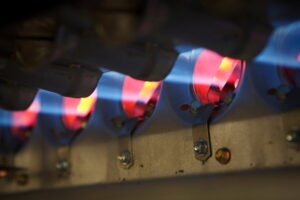 This blog post also could have accurately been titled, “How to Ensure Your Gas Furnace Operates Safely.” That said, we aren’t insinuating that gas powered furnaces are inherently dangerous. We’re not out to incite panic among homeowners. However, not taking care of your gas powered furnace could potentially make it dangerous.
This blog post also could have accurately been titled, “How to Ensure Your Gas Furnace Operates Safely.” That said, we aren’t insinuating that gas powered furnaces are inherently dangerous. We’re not out to incite panic among homeowners. However, not taking care of your gas powered furnace could potentially make it dangerous.
What we mean by this, is that you have to have it professionally maintained each year. Professional maintenance allows our technicians to comprehensively clean, adjust, and inspect each and every component within your system to ensure that nothing is out of place or showing signs of wear. One component in particular is especially important here—the heat exchanger.
Damaged heat exchangers aren’t common, and they are most likely to occur in aging furnaces—furnaces that are 15 years old or older. This doesn’t necessarily mean you won’t have this problem with a new furnace, but it is something to keep in mind. If your gas furnace is more than a decade old, it’s time to explore its potential risks—and a cracked heat exchanger could be one of these risks.
More about Heat Exchangers
The heat exchanger is an essential component within your gas-powered furnace. It’s the component in which the heat form the combustion gasses transfers to the air from the blower fan, before being distributed throughout your air ducts. Combustion gas cannot come into direct contact with the air, otherwise unhealthy fumes—namely, carbon monoxide—can end up entering the living space.
When a furnace is working as it should, combustion gas enters the heat exchanger. This is a metal, clam-shell shaped component. The heat of this gas raises the temperature of the metal, and as the air from the blower fan passes over it, heat gets transferred into your home through your ductwork and vents. In other words, your heat exchanger is what’s responsible for actually heating your home.
What Happens When a Heat Exchanger Is Damaged?
A damaged heat exchanger can allow exhaust fumes to enter your living space and potentially create a health and safety hazard. The most harmful of these exhaust fumes is carbon monoxide (CO). CO can cause serious health issues and even fatality. Typically, CO and other fumes are sent out through a flue during the heating process. But if the heat exchanger is cracked, then some can seep out and potentially come in contact with the air entering your home.
The most likely cause of heat exchanger damage is corrosion, and that’s why we said it’s a problem more common in older furnaces. What happens is that the reaction between the combustion gasses and the metal of the heat exchanger causes the metal to weaken over the years. And then, even the smallest crack or fissure in the metal can allow gasses in, since the metal crack will expand with the heat.
If you think your heat exchanger might be damaged—you hear clicking noises coming from the furnace as the blower shuts off—then it’s time to call in a professional HVAC technician. This is also the case if any of the carbon monoxide detectors/alarms go off in your home. Be sure to give us a call so we can help you get your furnace back to full functionality and help ensure your home is as safe as possible.
Covenant Heating and Cooling is “Dedicated to the Promise of Serving You.” Contact us for expert furnace repair in Brentwood, TN.
